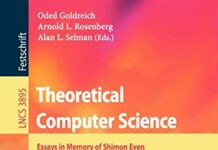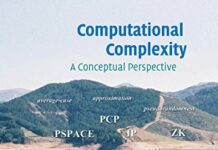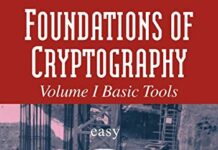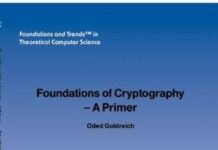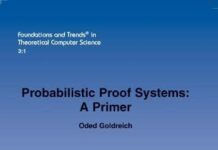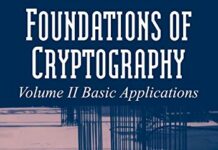
Ebook Info
- Published: 2010
- Number of pages: 207 pages
- Format: PDF
- File Size: 1.11 MB
- Authors: Oded Goldreich
Description
The focus of this book is the P versus NP Question and the theory of NP-completeness. It also provides adequate preliminaries regarding computational problems and computational models. The P versus NP Question asks whether or not finding solutions is harder than checking the correctness of solutions. An alternative formulation asks whether or not discovering proofs is harder than verifying their correctness. It is widely believed that the answer to these equivalent formulations is positive, and this is captured by saying that P is different from NP. Although the P versus NP Question remains unresolved, the theory of NP-completeness offers evidence for the intractability of specific problems in NP by showing that they are universal for the entire class. Amazingly enough, NP-complete problems exist, and furthermore hundreds of natural computational problems arising in many different areas of mathematics and science are NP-complete.
User’s Reviews
Reviews from Amazon users which were colected at the time this book was published on the website:
⭐Here is a copy of my review of the most recent book (Fortnow, 2013)
⭐on this topic, from a laymans view, then see below for comparative differences:==================================What an awesome book! P-NP is essentially the question of whether we can find solutions quickly if we can define or know there is a solution quickly– in layman’s terms, it means we know, and then can solve, the traveling salesman problem in “P” — polynomial — rather than exponential or infinite time, or not at all.There are a lot of technical books on the topic, but this is the first recent book that explores the golden ticket (finding the ONE in your batch of many that will allow you into Willy Wonka’s factory tour) in layman’s terms, but without talking down to the reader, and covering and focusing on all the aspects of the question. “How not to prove that P does not equal NP” as the author says, is an example of the complex and convoluted logic that’s needed to explore the field of computational complexity.Most authors, including this one, use public key crytography, factoring, etc. as examples of the “good” things about intractable problems, yet they also point out that if you could solve this problem, all the other millenium prize problems would likely also fall before you! That’s more than $5 million US, so this book is definitely worth a careful read! (Ok, little tongue in cheek).Contents include: The Golden Ticket, The Beautiful World, P and NP, The Hardest Problems in NP, The Prehistory of P vs. NP, Dealing with Hardness, Proving P does not equal NP (which this author believes), Secrets, Quantum, and The Future.This book is truly FUN and READABLE– Fortnow peppers every page with anecdotes, examples, side stories, cartoons, diagrams, and an amazing array of connections. Past explorations couldn’t even have asked if it’s possible to scan for the largest Facebook friends lists, because Facebook didn’t exist during most of the past P/NP books frames!If you want a more general intro to computational complexity, Neil Johnson’s little triple reprint from 07 to 2012 is outstanding:
⭐, and is under 10 bucks. For an exploration of how P/NP fits with the other current millenial problems, an outstanding new book is Ian Stewart’s
⭐. To go a level higher, and see how computational complexity fits more generally in Systems Science and systems thinking, Flood’s 2010 book is a gem:
⭐.NONE of these, however, are as gentle an introduction, with as complete and detailed coverage, as Fortnow. This is a must have if you have any interest in the biggest and toughest and perhaps most important problem of our age. The icing on the cake is the really fun read of a really dry topic!=======================OK, so how does Goldreich compare? Wonderfully! Goldreich is a great follow up to Fortnow if you liked the Golden Ticket as an intro, because Goldreich takes P/NP to the “next level” of problems, exercises, math, etc. Where Fortnow is a general readership intro, Goldreich is truly a “course” with teacher’s notes, etc. Very difficult problems, like the isomorphism of NP series, are presented in both examples and exercises. This is NOT a beginner’s book, and either requires a teacher/ coach / tutor, or good grounding with Fortnow et. al. before tackling it.Goldreich goes beyond P/NP, and more deeply INTO NP as well, and explores several computational complexity related tangents, such as Graph Theory, Comibinatorics, Promise problems, Search algorithms, Booleans, etc. Each of these are presented with a lot more theory, set math, exercises and problems than Fortnow. Significantly, Goldreich spends a LOT of time on Boolean circuits and satisfiability problems, which is a rare topic and hard to find in many CC texts outside of journals. SAT, CSAT and Boolean circuits in general are a fertile area for P/NP research.Goldreich has an excellent 33 item bib from the 30’s and 40’s through 2009, with a midpoint in the mid-2000’s. In contrast, Fortnow uses “chapter notes and sources” with a lot of articles, and even websites and emails he received! Neither author lacks scholarship, but it certainly demonstrates a difference in style!Library Picks reviews only for the benefit of Amazon shoppers and has nothing to do with Amazon, the authors, manufacturers or publishers of the items we review. We always buy the items we review for the sake of objectivity, and although we search for gems, are not shy about trashing an item if it’s a waste of time or money for Amazon shoppers. If the reviewer identifies herself, her job or her field, it is only as a point of reference to help you gauge the background and any biases.
⭐The book starts with some background material and then moves to the definition of search problems. On page 6 it starts with Definition 1.1 where it uses a notation I’m not familiar with. So I could not follow what the author is trying to say. I had to give up even before I had a chance to try and understand what he’s talking about. This book seems to be poorly written. I started the chapter on P,NP, NPC in the CLRS book. This has a similar notation that was explained and I could follow what was being said. I’ll come back to this book after my semester long MS course on Computational Complexity.
Keywords
Free Download P, NP, and NP-Completeness: The Basics of Computational Complexity 1st Edition in PDF format
P, NP, and NP-Completeness: The Basics of Computational Complexity 1st Edition PDF Free Download
Download P, NP, and NP-Completeness: The Basics of Computational Complexity 1st Edition 2010 PDF Free
P, NP, and NP-Completeness: The Basics of Computational Complexity 1st Edition 2010 PDF Free Download
Download P, NP, and NP-Completeness: The Basics of Computational Complexity 1st Edition PDF
Free Download Ebook P, NP, and NP-Completeness: The Basics of Computational Complexity 1st Edition
